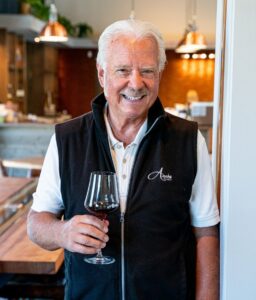
John Sweazy grew up in the Midwest and didn’t even so much as see a glass of wine until he went off to college. There, he encountered the standards of that era: Cold Duck, Mateus, and Lancers. After graduating from Stanford, he went into finance and real estate. In 1971, on an extended 25,000-mile journey around Europe, he began to see how significant a role wine played in everyday European culture. He was smitten and decided that someday he would own a winery. But he detoured to get married and have kids, and it took time to find the perfect land on which to build his dream winery, so it wasn’t until 2005 that his dream began to take shape. Today, Anaba Wines is an award-winning winery known for its Pinot, Chardonnay, and Rhone varietal wines. Here’s his story.
You grew up in the suburbs of Chicago in the 50s to 60s. Tell us about your family and the community where you resided. Was wine a part of your family meals? Do you remember the first time you tasted wine?
I grew up in a pretty typical middle-class suburb of Chicago (Park Ridge) in a pretty typical family with a father who worked and a mother who did not work outside of the home, though I never saw a glass of wine until I went to college. Freshman year I may have had a glass of Cold Duck. Fortunately, things got better.
You’re a Stanford graduate; what was your major and how did you land your first job after college?
I went to Stanford to major in Physics and after a year and a half, for some unfathomable reason, I realized it wasn’t for me. I ended up in Economics; I did take some computer science classes in my senior year, as that was the new thing to do, and that’s what inspired me to go work in sales at IBM.
After selling computers at IBM, you longed for a more creative career and went into commercial real estate. How did you make that leap in your career path and move from Chicago to the Bay Area?
I always planned to return to the Bay Area, and after deciding that working for a large corporation was probably not for me, I chose real estate as a hopeful avenue for financial success. I began with traditional commercial mortgage banking. Then I evolved into providing financing for affordable housing development and ultimately started my own mortgage banking company.
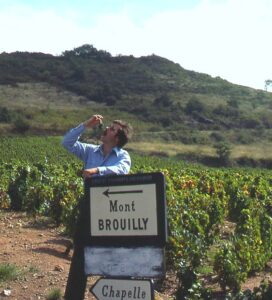 In 1971 you took an extended trip to Europe. Where did you visit and what was your favorite destination?
In 1971 you took an extended trip to Europe. Where did you visit and what was your favorite destination?
I visited almost all the Western European countries, driving 25,000 miles in 8 months, and was intrigued by how wine culture was so entrenched in Europe. The highlights of that trip included seeing the sun never set in Northern Finland and watching a camel caravan in the moonlight over the Sahara desert.
You’ve told us that you discovered wine while in college; when did you begin thinking you’d have a winery of your own someday? How many years did it take?
My college wine days were limited to Cold Duck, Mateus, and Lancers, except for the 4-5 trips I took to Napa Valley. It was only after making wine at home in the mid-70s and taking numerous trips to French wine regions that I was inspired to dream about having my own winery. In 1978, I met my wife-to-be, and she suggested we wait “until the kids were paid for” (though we were not married yet) and we started our search in 2002.
Around 2005 you found a piece of land in Carneros, where Anaba now stands. How did you find the property and what was on it, beside a few acres of pinot noir, before you built your new tasting room? Was it an easy undertaking to get where you are or were there roadblocks along the way?
It took almost four years to find a site in Sonoma that was easily accessible (for hospitality reasons) and convenient (for making the Burgundian and Rhone varieties I favored). We converted the 120-year-old house on the property into our offices and tasting room and started designing the new facility, which took much longer than anticipated for numerous reasons.
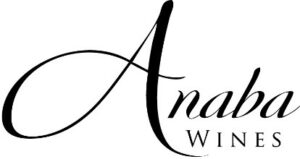 According to various sources, the name “Anaba” can have several meanings, including in Native American culture, “returning from war” or in Japanese culture, “hidden place.” There’s also the descriptor, “anabatic” which often describes winds that blow up a mountainside, warming the air as it rises. How did you choose the name Anaba for your winery?
According to various sources, the name “Anaba” can have several meanings, including in Native American culture, “returning from war” or in Japanese culture, “hidden place.” There’s also the descriptor, “anabatic” which often describes winds that blow up a mountainside, warming the air as it rises. How did you choose the name Anaba for your winery?
We had a very windy site, so Anaba worked as the name. We had hoped to use Mistral in our name, but, of course, it was taken. And, since wind became our theme, we decided to install a wind turbine on the property, and we were the first winery to do so in Northern California.
You have several vineyard partners, one of them being the Sangiacomo Family and their Roberts Road Vineyard. Your Chardonnay from this site was recognized as a People’s Choice at our 2024 Wind to Wine Festival. When did you begin sourcing grapes from Sangiacomo and how did you get connected? How do you go about choosing new vineyard sites from which to source fruit?
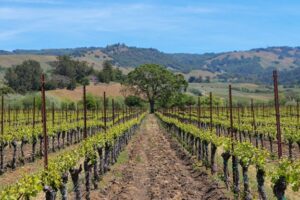 When we bought our property from Castle Vineyards, they had a relationship with the Sangiacomo Family, so they were the first grape growers we met and it was love at first sight! We’ve been producing Pinot Noir from their Roberts Road vineyard since the beginning, but we recently added Chardonnay to our portfolio. While we inherited several relationships from Castle, we soon started doing our research on other vineyards which we felt would be a good match. In 2014, when Katy Wilson and Ross Cobb became our consulting winemakers, we started developing these new relationships.
When we bought our property from Castle Vineyards, they had a relationship with the Sangiacomo Family, so they were the first grape growers we met and it was love at first sight! We’ve been producing Pinot Noir from their Roberts Road vineyard since the beginning, but we recently added Chardonnay to our portfolio. While we inherited several relationships from Castle, we soon started doing our research on other vineyards which we felt would be a good match. In 2014, when Katy Wilson and Ross Cobb became our consulting winemakers, we started developing these new relationships.
We know that Anaba, in addition to Pinot Noir and Chardonnay, also makes Rhone varietal wines. Have you considered making a Syrah from Gap grapes?
We are waiting to find a nice “windy” site in the Petaluma Gap for another Syrah offering.
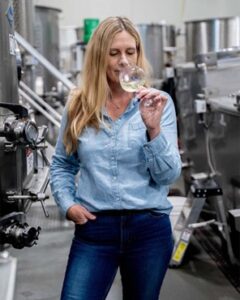 Your winemaker, Katy Wilson, has been with Anaba for ten years. How did you find Katy and how involved are you with the winemaking decisions? In 2019 you opened a production building; are all wines made onsite now? Is it true that you also have custom crush clients?
Your winemaker, Katy Wilson, has been with Anaba for ten years. How did you find Katy and how involved are you with the winemaking decisions? In 2019 you opened a production building; are all wines made onsite now? Is it true that you also have custom crush clients?
We found Katy through a mutual wine banker friend who felt it would be a great match – and it was! Yes, we produce all Anaba wines in our winery on the estate. I review all the wines we want to make with Katy and the quantities, and the actual winemaking I leave in her capable hands. We do have numerous custom crush clients which allowed us to build a larger, state-of-the-art facility.
What is your favorite variety?
I fell in love with Burgundian Pinot Noirs in 1975 when I was served what my host said was “a wine from Burgundy that I would really enjoy” and he was right–fortunately he could afford it as we were in a fancy London restaurant.
You have a new member of the Anaba team – Maxx – an adorable Siberian Husky. Is this your first winery dog? Any barn cats or other animals?
Through the years we have had several animals on property. When we opened the farmhouse, my cat, Thomas, became the first official pet. Since then we’ve had a couple of other cats – Gato and Molly (current residents). And we’ve had a few dogs, too, including Badu and the newcomer, Maxx.
Your wines win lots of awards, to whom does the credit go?
The credit goes to a great team, with Katy leading the winemaking department.
